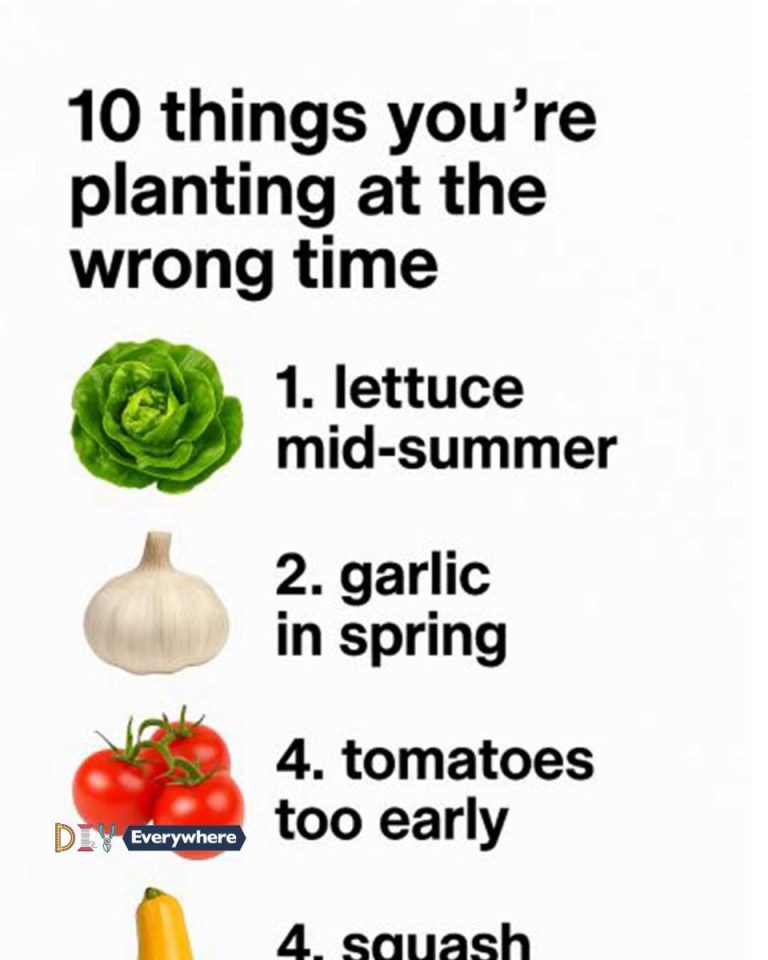10 things you’re planting at the wrong time

1. Planting Lettuce in Mid-Summer
Lettuce is a cool-season crop that thrives in the mild temperatures of spring and fall. Planting lettuce in mid-summer can lead to bolting, where the plant begins to flower and set seed prematurely. This happens because lettuce prefers temperatures between 60°F and 70°F (15°C to 21°C), and the heat of summer can cause stress.
To avoid this, plant lettuce in early spring as soon as the soil can be worked, or wait until late summer for a fall harvest. Using shade cloth or planting in partial shade can also help keep lettuce cool during warmer months.
2. Planting Garlic in Spring
Garlic is best planted in the fall, usually about 4-6 weeks before the ground freezes. This allows the cloves to establish roots before winter sets in. Garlic needs a cold period of around 32°F to 50°F (0°C to 10°C) to trigger bulb formation in the spring.
Spring planting can result in smaller bulbs because the garlic doesn't have enough time to develop fully before the heat of summer arrives. By planting in the fall, you ensure that your garlic has the necessary conditions for optimal growth.
3. Starting Tomatoes Too Early
Tomatoes are a warm-season crop that should not be started too early indoors, as they can become leggy and weak if they outgrow their pots before it's safe to transplant them outside. Generally, tomatoes should be started indoors 6-8 weeks before the last expected frost date.
Transplanting tomatoes too early, before the soil has warmed to at least 60°F (16°C), can stunt their growth. It's better to wait until the danger of frost has passed and the soil has warmed to ensure healthy, robust plants.
4. Sowing Squash Before Soil Warms
Squash plants are sensitive to cold soil and should not be sown until the soil temperature reaches at least 70°F (21°C). Planting squash too early can lead to poor germination and stunted growth.
Waiting for warm soil ensures that the seeds will germinate quickly and the plants will grow vigorously. If you're eager to get a head start, consider using black plastic mulch to warm the soil or start seeds indoors and transplant them once conditions are right.
5. Planting Peas in Late Spring
Peas thrive in the cool temperatures of early spring. They should be planted as soon as the soil can be worked, which is often four to six weeks before the last expected frost. Planting peas in late spring can result in poor yields because they do not tolerate heat well and will stop producing once temperatures consistently reach above 75°F (24°C).
By planting early, you give peas the opportunity to grow and produce pods before the heat of summer sets in.
6. Transplanting Basil Before Night Temperatures Rise
Basil is a tender herb that thrives in warm conditions and is very sensitive to cold. Transplanting basil outdoors before nighttime temperatures are consistently above 50°F (10°C) can cause shock and stunt its growth.
To ensure healthy basil plants, wait until the soil is warm and night temperatures are suitable. If necessary, protect young plants with row covers or bring them indoors during cold nights.
7. Sowing Carrots in Hot Weather
Carrots prefer cooler weather and should be sown in early spring or late summer for a fall harvest. Planting carrots in hot weather can lead to poor germination and misshapen roots.
Carrots need a soil temperature of around 55°F to 75°F (13°C to 24°C) for optimal germination. If you're planting in late summer, ensure the soil remains moist to encourage germination and consider using mulch to keep the soil cool.
8. Planting Strawberries in Summer
Strawberries should be planted in early spring or fall, not summer. Planting in summer can stress the plants due to heat and dry conditions, leading to poor establishment.
By planting in early spring or fall, strawberries have time to establish strong root systems before the challenges of hot weather or winter. This timing also aligns with their natural growth cycles, improving the chances of a successful harvest.
9. Starting Broccoli After Spring Begins
Broccoli is a cool-season crop that should be started early, about 6-8 weeks before the last frost, and transplanted outdoors 2-4 weeks before the last frost date. Starting broccoli after spring begins can expose it to warm temperatures, causing it to bolt and produce small heads.
To avoid this, plan your broccoli planting so that it matures in cool weather. This may mean starting seeds indoors while it's still winter or early spring.
10. Sowing Spinach in Warm Weather
Spinach is another cool-season crop that struggles in warm weather. It should be sown as soon as the soil can be worked in spring and again in late summer for a fall harvest. Planting spinach in warm weather can cause it to bolt quickly and become bitter.
To ensure a successful spinach crop, aim for soil temperatures between 45°F and 68°F (7°C to 20°C) and provide shade or mulch during warmer periods to maintain cool soil conditions.
11. Planting Radishes in Summer Heat
Radishes are fast-growing and prefer cool weather. Planting them in the summer heat can result in tough, woody roots and poor flavor. Radishes are best sown in early spring or late summer for a fall harvest.